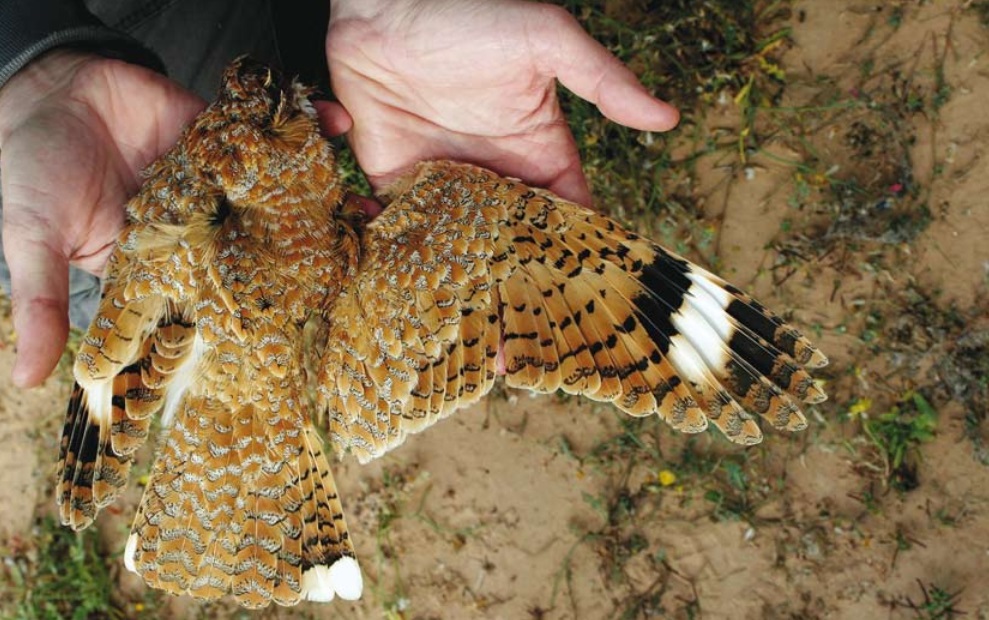A Golden Nightjar (Caprimulgus eximius) was observed crossing the road between Dakhla and Aousserd and hit by the observers’ car and died on 3 May 2015 (J. Dyczkowski & R. Smykala). This is the first confirmed record for Morocco and the Western Palearctic.

This interesting record confirms once more that the Aousserd region is one of the best birding hotspots in the Western Palearctic (WP). The best of what the region can offer includes:
- Cricket Warbler (Spiloptila clamans): the only other place inside the WP where the species is present is northern Mauritania.
- African Dunn’s Lark (Eremalauda dunni).
- Black-crowned Sparrow-lark (Eremopterix nigriceps)
- Sudan Golden Sparrow (Passer luteus): the species becomes more regular since a couple of years ago. Probably breeding locally in Aousserd or nearby?
In addition to these regular species, the region attracts now and then some good rarities such as White-throated Bee-eater (Merops albicollis) and African Crake (Crecopsis egregia).
Comments on the only historical record of Golden Nightjar in the WP
I revisit this record to add some information (thanks Mark Beaman for your comments, one quoted below and one added by himself in the comments’ section).
In ‘Bird of Morocco’ (Thévenot et al. 2003), the Golden Nightjar was included in the ‘list of omitted species’ (= not accepted). Here is the quote:
“Possibly an accidental visitor. A sighting at Guelta Zemmour in Oued Dahab, 6 June 1955 (Juan Valverde), is not accepted as this considered a Sahel resident”.
In addition to his brief comment below, Mark Beaman added more details in the following one:
I met Valverde in Seville in 1968 and worked with him measuring Marbled Teals which he had acquired from hunters. He showed me many skins in his collection including a Bald Ibis shot in Spain!
He told me about his finds in Morocco and Rio de Oro (Western Sahara). He was a first class ornithologist albeit old-school. Golden Nightjar is pretty distinctive; he was very familiar with all the usual suspects and was certainly not stringy. The reasons for subsequent rejecting of this record don’t hold up – “it is sedentary, it’s too unlikely“. Actually HBW suggests that there is some movement. The species is rare everywhere, so on the edge of its range it will be even more rare. There is plenty suitable habitat in southern Morocco but it is only likely to sing in late spring/early summer when few birders visit the region.
If the species is present, possibly resident, birds living near roads are more likely to become roadkill, wiped out and never discovered. Birds away from roads will have a better chance of survival but much less chance of discovery by birders. Birds of Africa and HBW both include Valverde’s record; they did not discount it on “unlikely grounds”. The first record should stand. Having visited the area to add Cricket Warbler and Dunn’s Lark to my list I think that there are more discoveries to be found in that rather special habitat.


Great record, but this is not the first record for the Western Palearctic. The species was already known from former Spanish Sahara = Western Sahara = now southernmost Morocco. Exactly, the previous record was from Guelta Zemmour in June 1955. Published by Valverde in 1957 and cited (accepted) by Birds of Africa, HBW etc. I was actually aware of that record when I first visited Morocco in 1968! I suspect that the species will eventually be found to breed locally in the south but few birders go there in late spring/summer.
Marc
Thanks Mark for your comment. Indeed this is not the first record but it's the the first unequivocally identified bird. Of course, the first observation by José Valverde in 1955 has it's merit especially now we know that it's likely for this Sahel resident to turn up much to the north.